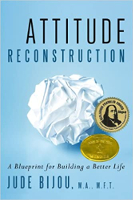
Image by Jan Vašek
According to Attitude Reconstruction, “stress” means we've lost our healthy perspective about time and are governed by our suppressed fear. We're gripped by the future and what needs to be done and worry about our worst-case scenarios. Maybe we're off to college. Maybe we have an important interview. Maybe it's managing the household, kids, finances, and a job.
We've become so focused on how we'll maneuver to fit it all in, that we no longer stop to smell the roses or breathe in the fresh air. Desperately we strive to gain control over the unknown. And as a result, we call ourselves "stressed" out. Does this apply to you or someone you know?
AR Survey Confirms: We're Stressed!
Periodically I look at the data from all the folks who complete the Attitude Reconstruction "quick questionnaire" on my website. To date over 8000 people have taken the survey. The results show the magnitude of fear, aka, stress (such as too much to do, not enough time, and feeling pressure) in our lives today. (Click here if you want to take the free Attitude Reconstruction survey.)
There are twelve universal attitudes that are associated with the three emotions -- sadness, anger, and fear. There are four tied to each emotion. The strongest two attitudes as reported by survey participants are associated with the emotion of fear.
* 70.7% of people surveyed said they were in the future or past "half the time," "often," or "most of the time." That could mean that less than three out of ten of the people you are interacting with are actually present!
* 57.5% said they were attempting to control "half of the time" or more. Controlling other people and things or themselves is an indicator of unexpressed fear. Yikes. We're preoccupied and trying to hold it together, and it's pissing us off and negatively impacting our quality of life.
The survey results illustrate the degree of stress many of us experience every day. We're living in the future with too much to do and not enough time, trying to control people and things to keep it all together, and getting down on ourselves for our inability to get it all done perfectly.
Meet The Seven Stress Busters
Here's the short list of things you can do to dissolve "stress."
1. Make it physical.
Shiver for as long as you can. It works! While shivering only think and repeat out loud:
"It's okay." or "Everything will be all right."
Instead of feeling tense and tightening up your muscles, release the fear using your body. When you feel stressed, let your body do what's natural: wiggle, jiggle, shudder, tremble, and quiver - like a dog at the vet.
It may sound strange at first, but if you physically express the emotional energy with vigor - up the spine, out the arms, hands, legs, and in the neck and jaw - it will move out of your body and you'll quickly feel more calm, centered, and focused. While shivering, don't fuel your doom-and-gloom thoughts, just remind yourself: "It's okay to feel scared. It's okay. I just need to shiver."
2. Stay specific.
Don't allow yourself to entertain thoughts about everything at once.
" One step at a time." or "One thing at a time."
It's common when we're feeling panicked to fuel our fear with words like "always" and "never," as in "I'm always failing," or "I'll never get this done." Interrupt such thoughts about the future and past, and other over-generalizations that distort and magnify the problem. Instead, stay present and be specific.
3. Break it into parts.
Break big projects into a series of simple little pieces and attend to one thing at a time. The key to managing fear and life's tasks is to take the time to get organized every day. For each task you take on, start by articulating your goal. With that in mind, break the desired goal into a series of little doable steps. Each step must be made small enough so you know you can finish it.
If you keep an ongoing list of exactly what needs to be done by when, you can evaluate what's most important and essential for today. Put your list in an obvious place so you can see it. Then just do what's next, offering yourself copious praise along the way.
4. Say "no" more often.
Delegate when possible. Say "no" more often to invitations of responsibility. Folks who are over-committed have a tendency to believe that if they don't do it, it won't get done. This stems from their need to be in control in order to feel safe. The problem is that needing to be in charge keeps you overstimulated and overwhelmed.
The world won't collapse if someone else does it his or her way. People won't abandon you, and you'll still be a good person. Practice letting others pick up the slack.
5. Stop letting your mind run wild.
The constant thoughts and chatter running through your head exacerbate your feelings of anxiety and pressure. Interrupt those thoughts and replace them with a reassuring and calming statement. Some examples: "Everything is all right. One thing at a time. I'll handle the future in the future. Be here now."
6. Breathe.
Take a few minutes here and there to step back and refresh yourself. Take a leisurely walk. Take a snooze.
7. Be easy on yourself.
Keep interrupting the inner critic and instead offer yourself appreciations and praise. "I'm doing the best I can. " "I did good."
8. Adopt a relaxed, more conscious routine.
Make lifestyle choices that help you achieve a regular, more relaxing life. To feel calmer, you must reduce the amount of stimulation you expose yourself to. That means spending more time with less frightening or less anxiety-producing activities, situations, people, movies, games, and other stimuli.
Get more sleep. Meditate. Do gentle yoga, tai chi, or qigong. Don't miss meals. Cut down on coffee, energy drinks and cold foods and drinks. Stay out of cool, damp, and drafty places.
Final words
By following one or two of these seven simple suggestions, you'll be able to reduce and manage your stress level. I suggest you pick a couple of strategies and have them at the ready. Break things into doable steps, and shiver when you stall. You'll find that you enjoy whatever your day brings and can willingly participate with humor and equanimity.
©2023 by Jude Bijou, M.A., M.F.T.
All Rights Reserved.
Book by this Author: Attitude Reconstruction
Attitude Reconstruction: A Blueprint for Building a Better Life
by Jude Bijou, M.A., M.F.T.
 With practical tools and real-life examples, this book can help you stop settling for sadness, anger, and fear, and infuse your life with joy, love, and peace. Jude Bijou's comprehensive blueprint will teach you to: ? cope with family members' unsolicited advice, cure indecision with your intuition, deal with fear by expressing it physically, create closeness by truly talking and listening, improve your social life, increase staff morale in just five minutes a day, handle sarcasm by visualizing it flying by, carve out more time for yourself by clarifying your priorities, ask for a raise and get it, stop fighting via two easy steps, cure kids' tantrums constructively. You can integrate Attitude Reconstruction into your daily routine, regardless of your spiritual path, cultural background, age, or education.
With practical tools and real-life examples, this book can help you stop settling for sadness, anger, and fear, and infuse your life with joy, love, and peace. Jude Bijou's comprehensive blueprint will teach you to: ? cope with family members' unsolicited advice, cure indecision with your intuition, deal with fear by expressing it physically, create closeness by truly talking and listening, improve your social life, increase staff morale in just five minutes a day, handle sarcasm by visualizing it flying by, carve out more time for yourself by clarifying your priorities, ask for a raise and get it, stop fighting via two easy steps, cure kids' tantrums constructively. You can integrate Attitude Reconstruction into your daily routine, regardless of your spiritual path, cultural background, age, or education.
For more info and/or to order this book, click here. Also available as a Kindle edition.
About the Author

Jude Bijou is a licensed marriage and family therapist (MFT), an educator in Santa Barbara, California and the author of Attitude Reconstruction: A Blueprint for Building a Better Life.
In 1982, Jude launched a private psychotherapy practice and started working with individuals, couples, and groups. She also began teaching communication courses through Santa Barbara City College Adult Education.
Visit her website at AttitudeReconstruction.com/



























